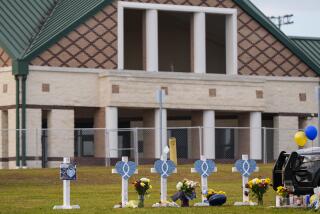2 Dead After Standoff at Colo. School
BAILEY, Colo. — For four hours, SWAT team officers had been shouting through a classroom door, trying to communicate with the unidentified man terrorizing Platte Canyon High School. The man had a gun. He said he had a bomb. He was holding two teenage girls hostage. And he was using at least one of the girls as a human shield.
The man had walked into the high school shortly before noon Monday and had swiftly taken six girls hostage. Over the next few hours, negotiators had some success defusing the crisis; the gunman had released four of the students, one by one.
But it was now 3:30 p.m., and the stranger had stopped talking.
His last message -- relayed through one of his hostages -- warned that something dire would happen at 4 p.m. Then silence.
Minutes passed.
Park County Sheriff Fred Wegener made the call: He ordered the SWAT team in.
In the blur that followed, the gunman shot one of his hostages. He fired on the officers. Then he turned the gun on himself, committing suicide.
Law enforcement officers rushed the second hostage to safety. But the first girl, who had recently turned 16, was fatally wounded. She was pronounced dead at a trauma center in Denver, about 35 miles north.
The girl’s name was not released, at her family’s request. A family friend described her as bubbly and bright. “Every time you see her, she gives you a hug,” Lynn Bigham said.
The tragedy left this rustic mountain town -- and its small sheriff’s department -- stunned and grieving. Sheriff Wegener knew the victim’s family well. His son had been in the high school. He could not hold his voice steady as he talked to reporters; his eyes welled often, and his hands ceaselessly folded and unfolded a page torn from a legal pad.
“I’ll be honest,” Wegener said, describing his emotions when the first 911 call came from the school. “I was scared to death.”
Hours after the standoff ended, authorities had few answers for this community of less than 10,000.
They had not yet identified the gunman, described as a male at least 30 years old.
“At this point, we would consider [him] to be nothing more than a John Doe,” Steve Johnson of the Colorado Bureau of Investigation said at an evening news conference.
Authorities had not identified a potential motive either, or possible links between the shooter and his hostages. They had not even finished clearing the area; a bomb squad unit was continuing to search the high school and adjacent middle school for possible explosives well into the night. Both schools were to be closed the rest of the week.
“I don’t know why he wanted to do this,” Wegener said, blinking hard. The only demand the sheriff said he heard the gunman make during the long, tense afternoon was this: “He wanted us to back off.”
The incident brought back the horror of the shootings at Columbine High School, less than an hour’s drive away. On April 20, 1999, two students killed 13 people at Columbine, in the Denver suburb of Littleton, before committing suicide.
The Columbine siege forced a radical change in law enforcement’s approach to this type of crisis. Back then, the protocol was for first responders to set up a perimeter, call a SWAT team and then wait at a distance. But that response was widely criticized for giving the teenage gunmen time to roam the high school, methodically killing victim after victim.
After Columbine, law enforcement across the nation began training to move in at once and try to contain the shooter.
“That was the No. 1 lesson learned from Columbine,” said Kenneth Trump, president of National School Safety and Security Services, a consulting firm based in Cleveland.
Wegener and his deputies had trained on this new protocol -- known as the “active shooter rapid response.” They had also run drills with the staff at Platte Canyon High School, including one last month, before school started.
As a result, Wegener said, they were able to contain the gunman and his hostages in a single classroom almost immediately, with help from the Jefferson County Sheriff’s Office, the lead agency responding to the Columbine shooting seven years ago. School authorities announced a “code white” -- signifying a lockdown -- and deputies were able to evacuate the rest of the students and staff safely. The students were taken by bus to a nearby elementary school, where parents were waiting to hug them close.
“Based on what I could see from afar,” Trump said, “both school and law enforcement actions appeared to follow the textbook model of how we train.”
Asked whether he was second-guessing his decision to send in the SWAT team, Wegener looked up slowly, his face drained.
“Yes,” he said.
And then, even more quietly: “Of course.”
*
More to Read
Sign up for Essential California
The most important California stories and recommendations in your inbox every morning.
You may occasionally receive promotional content from the Los Angeles Times.










